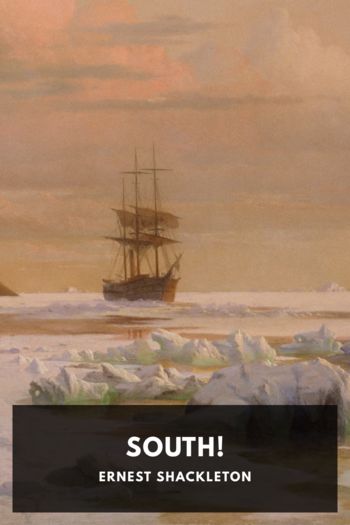The Diezmo, Rick Bass [spiritual books to read .TXT] 📗

- Author: Rick Bass
Book online «The Diezmo, Rick Bass [spiritual books to read .TXT] 📗». Author Rick Bass
It had literally been carved into the mountain. The jutting neck of an old volcano had been cut out, countless buckets of rubble and slag hammered and hauled away by Indian slaves, across the centuries—and scattered across the blackened mountain, where basalt had been forged and cast by the earth’s original fire and then cooled beneath the breath of the world, were other parapets and turrets, the remnants of smaller volcano necks in which soldiers could take refuge and fire upon any approaching armies.
So perfectly did the fort blend into the rainy black mountain that at first glance I didn’t even see it. Once I had detected its subtle pattern against the mountains, a kind of horror grew as I realized the size and extent of it—that the entire mountain face was a fortress and prison.
As we approached, we saw that cannons protruded from every embrasure. Our captors raised the flag of Mexico and called out, and in a driving rain we crossed a moat twenty feet deep and fifty feet wide, and entered the gates, which were made of giant cedar logs and were defended by countless high parapets with guns and cannons protruding in all directions. The stone walls themselves were sixty feet high, and, looking up, it seemed to us that there was an entire nation of soldiers atop those walls, all of them peering down at us as we had earlier gazed down at the tiny creatures living in the water-filled cups of the orchids.
The water in the moat was sparkling clear. Lily pads, their blossoms alternately butter yellow and snow white, floated in the crystal waters, and white swans paddled back and forth, elegant and yet strangely military-looking. We studied them hungrily and imagined how good they would taste. Bigfoot Wallace tossed a rock at the swans and one of the larger drakes responded with a high squeal. Wallace warned us that the swans were sentinels and would sound an alarm if we tried to escape.
The first thing we saw upon entering the prison—other than the legions of guards assigned to defend it, and to stand watch over all the other prisoners already assembled there, generations of military and political prisoners—was a torrent of clear sparkling water gushing from the roaring wide mouth of a stone-carved lion. Channels had been carved and dug so water could run beneath the fort in underground aqueducts, and, looking back out at the windy pumice desert, just before the gates closed for good, we saw now that there were numerous such lions and bears and gargoyles carved into the cliff’s walls, their fierce mouths and once sharp fangs polished from where water had coursed in the past. We understood that, besides serving as a barrier, the water could also be used as a weapon: certain underground flows could be adjusted and transferred to cause great torrents of water to begin spouting from the mouths of the animals, making it more difficult for an attacking enemy to scale the walls.
The immense, uninhabited mountains towering above us—the snowfields and glaciers—yielded a steady and perhaps limitless supply of clean water to the fort, water that passed through those engineered channels and reservoirs before draining back underground and beneath us, audible through the porous rock in those secret aqueducts. Hearing it splash and splatter out into the moat beyond, I was reminded of the strange dream that young John Alexander had had up in the Sierra de la Paila mountains following our flights from Salado, back when we had been dying of thirst.
Our first act in the prison at Perote, in the Castle of Perve, was to kneel around the plunge pool beneath the mouth of the lion and drink like cattle from those clear waters, with the sound of the heavy gate being closed and latched tight behind us.
We had imagined we might be housed in separate cells, so we were surprised and relieved to discover that we would all be herded into one long common room. Our captors led us down an ever-darkening hallway, past the heavy oaken doors of other such rooms in which the prisoners from other nations and even from Mexico herself were housed; and as we passed by each door, the inhabitants within, as if by some divine intuition, were able to discern our passage, and though they knew nothing of who we were or how we had come to be here, they each set up a howling and banging clamor, a blind and unknowing welcome.
We descended a flight of stone steps, as cold and dark and dank as would be our room itself, and stopped at a doorway, where there was a lectern with a cracked leather-bound journal atop it, a registry of all the prisoners who had occupied, for whatever periods of time, this one particular room in Perote across the centuries. As Charles McLaughlin thumbed through it, he stopped at one entry from only a few years earlier, September 1839, and read, “The walls of our dungeon are smoke-stained black and brown. The limestone plaster is still visible in only a few places. White saltpeter, which forms everywhere, is the only adornment of our damp abode. Spreading along the cracks in the walls and ceiling, it solidifies into formations of various shapes. With a little imagination one can see animals, human profiles, Saturn’s rings, the Milky Way, the isthmus of Panama, and other things. The floor, half brick and half limestone mortar, is full of holes and not too easy to walk on. In one corner... there is a barrel; one can easily guess its purpose without my describing it. In the opposite corner there is another barrel that contains water, our daily beverage. On wooden pegs, protruding rocks,





Comments (0)